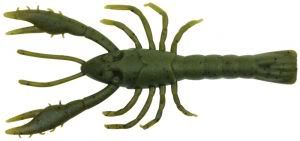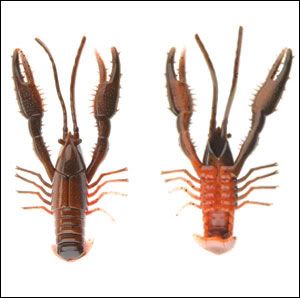A million baits and lures flood the fishing market, some are new and some are old and reliable. Recently I was thinking about the long list of bass baits that do a great job. And one that I think a lot of people have not seen or overlook for the real thing.

The realistic craw is an A+ in any fishery that craws exist. Most of the places fished have the crawling crustaceans somewhere in their system and in my opinion either people don’t realize that they are a viable bait or they overlook them for something they see the pro guys using because they endorse it. An even simpler reason that people probably skip the idea of the plastic craw is because they just go buy the real thing.
Simply said, bass cannot stay away from these feisty candies! This is the case all year long, however just like any other lure, there is a time of year that they will work the best. Fall and winter are prime times to use a craw pattern, though it will work year round. The difference between colder water presentations and warmer water presentation is that as the water warms bass tend to focus on schooling fish because the warm water makes them a lot more agile.
Real craws are great although they are sometimes hard to get hold of and you have to keep them alive or they are not worth putting on the hook. Real craws are also fragile, a one cast last type of bait. Plastic craws offer a more stable lure, and they are offered with a weight to get them to the bottom faster and keep them there. Another plus to a plastic craw is that in most cases they will last quite a while. To be clear I am speaking of very realistic lures, ones that you could mistake for the real thing. Huddleston, Berkeley, Strike-Pro, and MadMan are just a few to offer this very real design. If you look into it there are also a few Bass Master guys that have won a lot of money with these lures, so they are proven on the national stage.

Tying on a jig with a trailer is a popular craw pattern that people opt to when the fishing presentation has to be slow. In places like California, Texas, Alabama, Louisiana, and Florida, craws are present during most of the year because the weather never gets too cold. Other places that a cruel winter exists, you can most likely find the craws and the craw pattern are viable the warmer half of the year. I prefer to use plastic baits, that said, the plastic craw is natural for me and very easy to use. So when you’re thinking of tying on a jig, try out another soon to be favorite and tie on a realistic plastic crawfish.
So down to the details, if you’re thinking about trying this type of bait out, go get yourself a pack of whatever looks good to you. I prefer the realistic color patterns, realistic is the key to this whole thing. If you see the color pattern in the water you’re fishing, use it. Study the food chain, craws change color throughout the year. If you cannot see them year round, go online, study information about the prey you’re trying to imitate.

Throw them at whatever you want, these lures are versatile and effective in many situations. From shallow water, bedding bass, to the 20 foot range, these lures will work. Understand the way you work them, study the way a craw moves and learn to imitate it. Craws will both crawl slowly and dart rapidly. Try a Texas rig with up to a 3/16-ounce weight, wait for it to hit the bottom and throw it at docks, tree stumps, and rocks. On your retrieve, you can work it back rapidly with darting motions or twitch it to make minor movements for sluggish bass. The third option would be to shake the tip of your rod, making the lure jump in place. Give it a few seconds and do it again. Some realistic craws come pre-weighted and are perfect for bottom use while other don’t have “built in” weight and are very suitable for all ranges to include suspended bass. I have caught them by shaking them as I bring them up in the water columns.
Bedding bass are very protective and weather they are protecting a nest or just swimming by a slow approach sight fishing will produce bites as well. Throw your lure into a bed and wait for a bass to swim by, with a small shake of the lure you will often induce a reaction bite. In my use and in my opinion the best way to use these lures is slow and deliberate. Crawfish usually have slow and methodical movements unless fleeing a predator. Surprisingly if a craw gets caught in the open by a bass they will try to defend themselves first rather then flee. This usually ends in the craws pincher’s getting ripped off before a crushing death.
I have cracked some of very hard lakes using this lure. It is not always a big fish getter, however solid sizes are consistently hooked. Learning new ways to create a bite is what fishing is all about to me, being that a highly pressured area often causes fish to go into a state that I like to call Lock Jaw. Finding new ways to present an easy meal for the fish we pursue is a sure way to be a step ahead of our fellow anglers and catch fish year round when others are not.
Tight Lines,
Joshua “Kayak” Christensen
You can visit me at Get’n Fishy
